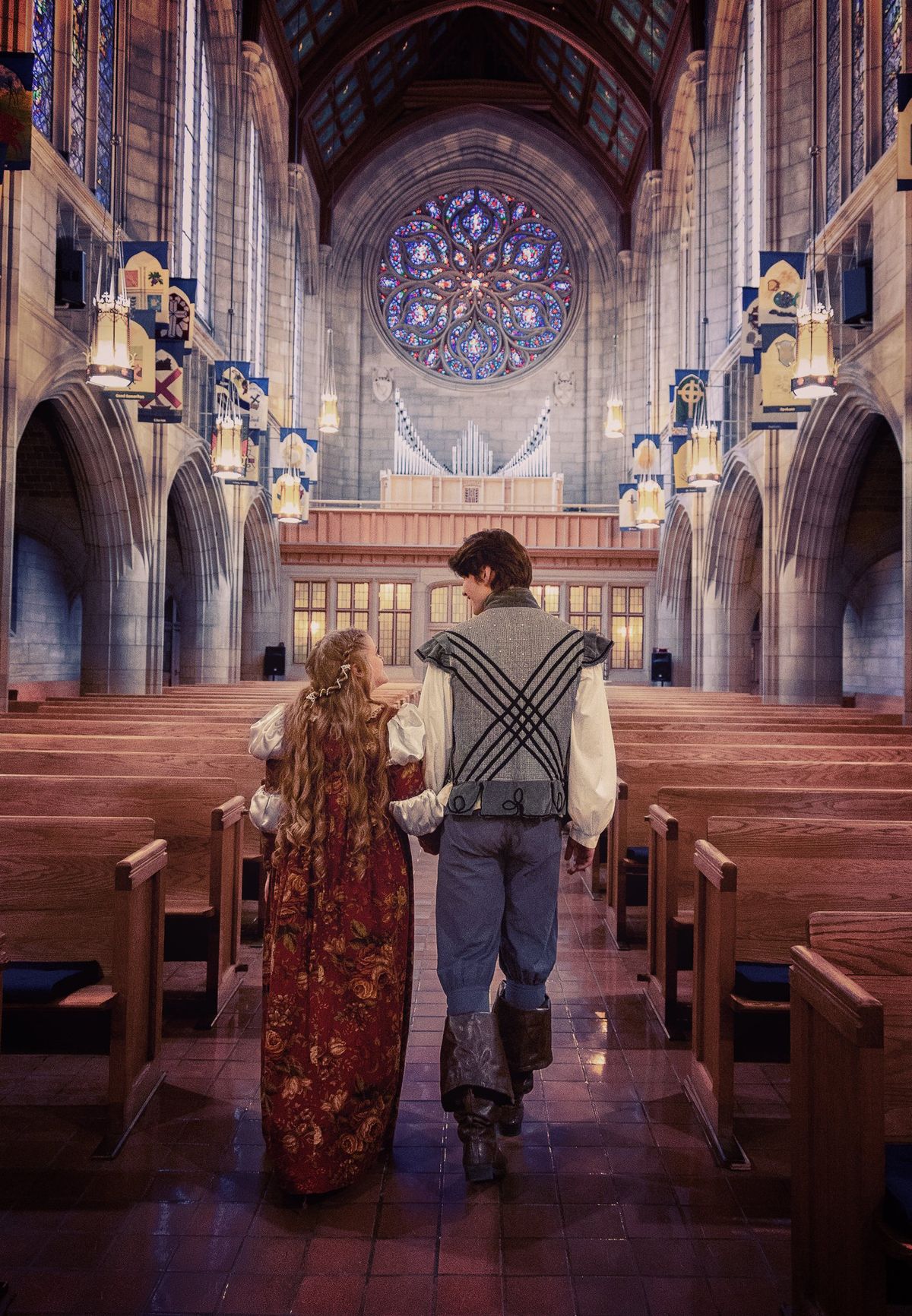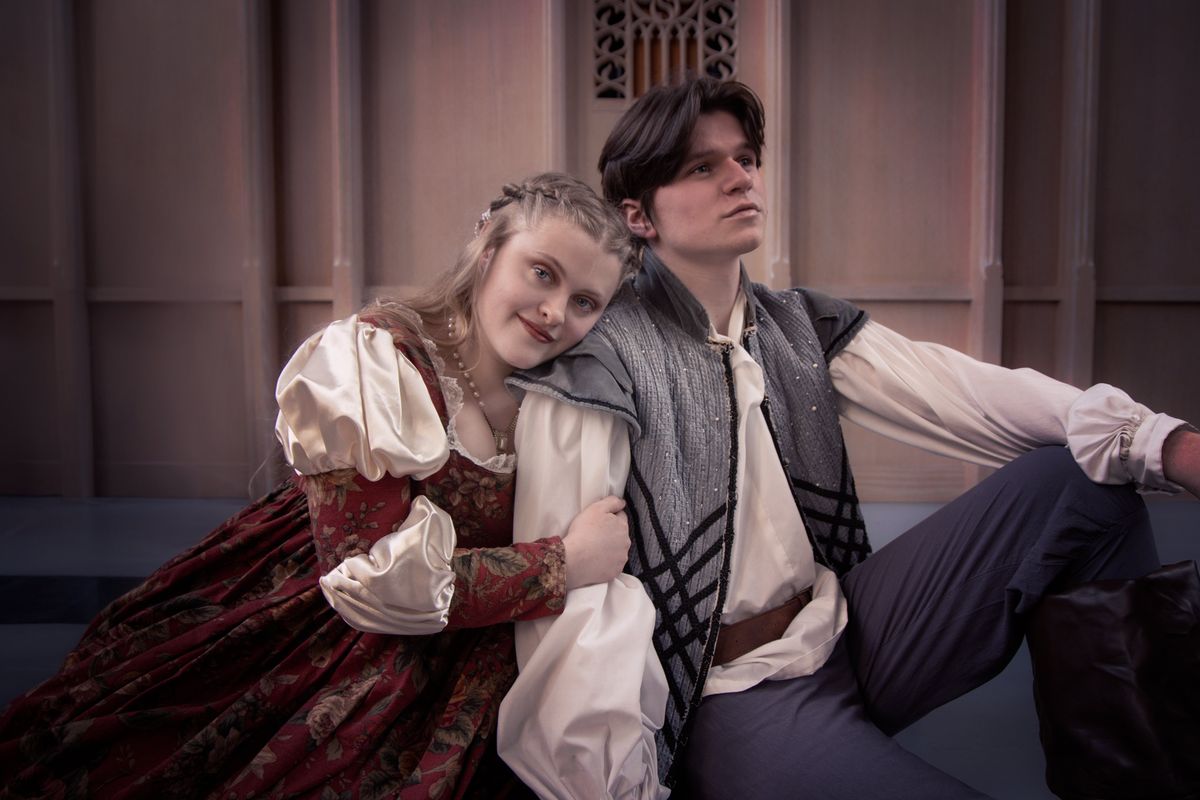‘It’s got dancing, it’s got sword fighting, it’s got a party’: Spokane Civic Theatre brings the Bard back to the main stage in ‘Romeo and Juliet’
Heather Stephens (Juliet) and Abe McKinney (Romeo) lead in Spokane Civic Theatre’s “Romeo and Juliet,” running through April 13. (Courtesy of Marlee Melinda Andrews)
Though they produced a staged reading of William Shakespeare’s “Romeo and Juliet” during the 2017-18 season, the last mainstage production of the play at Spokane Civic Theatre was during the 1996-97 season.
And the last Shakespeare show, tragedy or comedy, on the mainstage was “Macbeth” during the 2000-01 season.
So when Executive Director Jake Schaefer reached out to Joshua Baig, who directed the Civic Academy production of “Comedy of Errors” last year, about potentially bringing the Bard back to the mainstage, Baig immediately thought of either “Hamlet” or “Romeo and Juliet.”
The latter, he told Schaefer, had everything you could want in a show.
“It’s a love story, but it’s also a tragedy,” he said. “It’s got dancing, it’s got sword fighting, it’s got a party. It’s beautiful poetry and imagery.”
Schaefer was not only on board with Baig’s suggestion, but also interested in having Baig himself direct the show, an opportunity Baig felt he couldn’t turn down. His production of “Romeo and Juliet” opens Friday and runs through April 13 at Civic.
The play opens in Verona, where the Montague and Capulet families are sworn enemies. After a scuffle between servants for both families, Princess Escalus (Abby Constable) declares that any further fights will be punishable by death.
Later, Count Paris (Justin Bees), a family member of Princess Escalus, speaks with Lord Capulet (Samuel Peters) about marrying his daughter Juliet (Heather Stephens). Capulet asks Paris to wait two years, though he does invite Paris to the family ball.
Lady Capulet (Abby Burlingame) and Juliet’s nurse (Belinda Geren) try to persuade Juliet to accept Paris’s attempt to connect.
At the same time, Benvolio (Jared Martin) talks with his cousin Romeo (Abe McKinney), the son of Lord Montague (Jeffrey Ridlington). Benvolio discovers that Romeo is depressed after being rejected by Rosaline, one of Lord Capulet’s nieces.
Benvolio and Romeo’s friend Mercutio (Christopher Rounsville) persuade Romeo to attend the Capulet’s ball in hopes he’ll see Rosaline, but instead Romeo falls in love with Juliet. Juliet’s cousin Tybalt (Nathan Davies) is upset that Romeo has snuck into the family ball, but Lord Capulet stops him from killing Romeo.
After the ball, Romeo and Juliet profess their love for one another during the beloved balcony scene and decide to secretly marry with the help of Friar Lawrence (Jeffrey St. George) the next day.
The marriage, though initially joyful, leads to murder, a revenge killing, exile, an attempted arranged marriage, and potions and poisons, drunk because of misunderstandings, famously leading to the end of the “star-crossed lovers.”
“Romeo and Juliet” also features Laureen Savage as Lady Montague. The ensemble features Carrie Bostick, Eupheme Carruthers, Nathan Miller, Nicholas Roy Morgan III, Katelyn Orchard, Connie Mack Overstreet, Max Quintal, Hazel Rogers-Brunt, Clay Sanchez, Joseph Selle, Mo Stuart, Micah Sybouts, Robyn Urhausen and Kafziel Wynshester.
Shakespeare is partly to thank for Baig’s theatrical career. Baig didn’t realize his interest in theater until he took a required introduction to theater course taught by Bill Marlowe at Spokane Falls Community College. Baig loved the class so much, he switched his major to theater.
“Richard III” was the second play Baig took part in. From there, he added parts in “A Midsummer Night’s Dream,” “Hamlet” and “Measure for Measure” to his resume, then continued at Eastern Washington University with “Love’s Labour’s Lost” and “The Tempest.”
“I’ve always been able to understand it, and I’ve always enjoyed it,” Baig said.
Baig, who builds sets at Civic, said his main challenge when approaching “Romeo and Juliet” was figuring out how to cut the script down. Gone are the days when theater was the only entertainment available, so sitting for a four-hour show wasn’t a problem. Now, directors have to trim the script while being careful not to butcher the story or the language.
Baig worked on cutting the script for five months, watching other productions of the play and seeing what cuts they made. Once he had something a little lighter to work with, Baig, along with Assistant Director Marlowe, who Baig said he couldn’t have done the show without, did yet another round of edits to get to the script they could work with on this production.
Though he understands the appeal of modern takes on classical pieces, Baig’s production of “Romeo and Juliet” is “as classical as can be.” The costumes are period appropriate to the Elizabethan era, and the stage is set with a castle worthy of the Capulets with space for dancing and dueling.
Baig introduced the actors to fight training and dance classes early in the rehearsal process so they had as much time as possible to get comfortable with those elements of the show.
“I’m very proud of the actors,” he said. “This was a huge undertaking, and I couldn’t be more proud of what has transpired over the last couple months. My vision, these guys exceeded what I wanted.”
As Baig has gotten older, he’s developed an even greater appreciation for Shakespeare’s work, though he understands that some people are reluctant to take in one of his plays because of their unfamiliarity with his language.
He stresses though that reading the play is very different from seeing it on stage, where the actors recite Shakespeare’s words with the proper inflection and with pauses that help the audience understand his intent.
The emotions each character experiences also come across loud and clear to help tell the story.
“These actors, Romeo and Juliet, are just incredible and so believable,” Baig said. “There’s going to be some heartbreak and some tears.”


